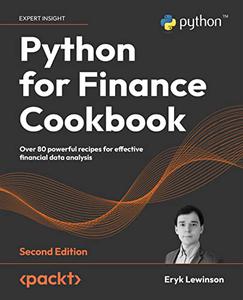
Python for Finance Cookbook
by Lewinson, Eryk;
English | 2022 | ISBN: 1803243198 | 741 pages | True PDF | 61.68 MB
Use modern Python libraries such as pandas, NumPy, and scikit-learn and popular machine learning and deep learning methods to solve financial modeling problems
Purchase of the print or Kindle book includes a free eBook in the PDF format
Key Features
Explore unique recipes for financial data processing and analysis with PythonApply classical and machine learning approaches to financial time series analysisCalculate various technical analysis indicators and backtesting backtest trading strategies
Book Description
Python is one of the most popular programming languages in the financial industry, with a huge collection of accompanying libraries. In this new edition of the Python for Finance Cookbook, you will explore classical quantitative finance approaches to data modeling, such as GARCH, CAPM, factor models, as well as modern machine learning and deep learning solutions.
You will use popular Python libraries that, in a few lines of code, provide the means to quickly process, analyze, and draw conclusions from financial data. In this new edition, more emphasis was put on exploratory data analysis to help you visualize and better understand financial data. While doing so, you will also learn how to use Streamlit to create elegant, interactive web applications to present the results of technical analyses.
Using the recipes in this book, you will become proficient in financial data analysis, be it for personal or professional projects. You will also understand which potential issues to expect with such analyses and, more importantly, how to overcome them.
What you will learn
Preprocess, analyze, and visualize financial dataExplore time series modeling with statistical (exponential smoothing, ARIMA) and machine learning modelsUncover advanced time series forecasting algorithms such as Meta's ProphetUse Monte Carlo simulations for derivatives valuation and risk assessmentExplore volatility modeling using univariate and multivariate GARCH modelsInvestigate various approaches to asset allocationLearn how to approach ML-projects using an example of default predictionExplore modern deep learning models such as Google's TabNet, Amazon's DeepAR and NeuralProphet
Who this book is for
This book is intended for financial analysts, data analysts and scientists, and Python developers with a familiarity with financial concepts. You'll learn how to correctly use advanced approaches for analysis, avoid potential pitfalls and common mistakes, and reach correct conclusions for a broad range of finance problems.
Working knowledge of the Python programming language (particularly libraries such as pandas and NumPy) is necessary.
Table of Contents
Acquiring Financial DataData PreprocessingVisualizing Financial Time SeriesExploring Financial Time Series DataTechnical Analysis and Building Interactive DashboardsTime Series Analysis and ForecastingMachine Learning-Based Approaches to Time Series ForecastingMulti-Factor ModelsModelling Volatility with GARCH Class ModelsMonte Carlo Simulations in FinanceAsset AllocationBacktesting Trading StrategiesApplied Machine Learning: Identifying Credit DefaultAdvanced Concepts for Machine Learning ProjectsDeep Learning in Finance
https://1dl.net/jwk27ldjhqym/569bh.P.f.F.C.O.80.p.r.f.e.f.d.a.2.E.rar

https://rapidgator.net/file/cbe62a0837577a6c60c723a421f05bfb/569bh.P.f.F.C.O.80.p.r.f.e.f.d.a.2.E.rar.html

https://nitroflare.com/view/3692C208BCCBC9C/569bh.P.f.F.C.O.80.p.r.f.e.f.d.a.2.E.rar

https://uploadgig.com/file/download/6813ecDBb982E1e4/569bh.P.f.F.C.O.80.p.r.f.e.f.d.a.2.E.rar
